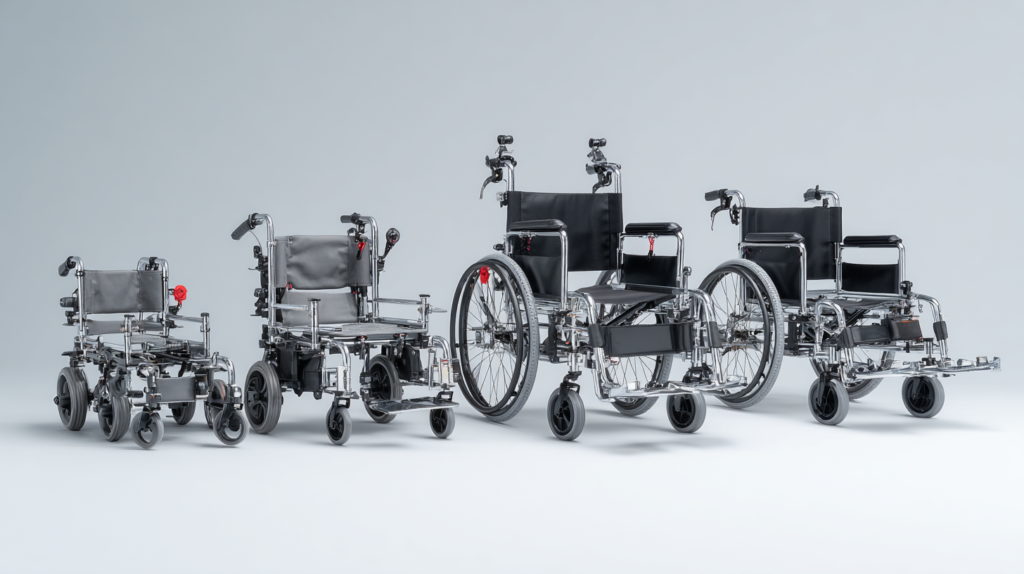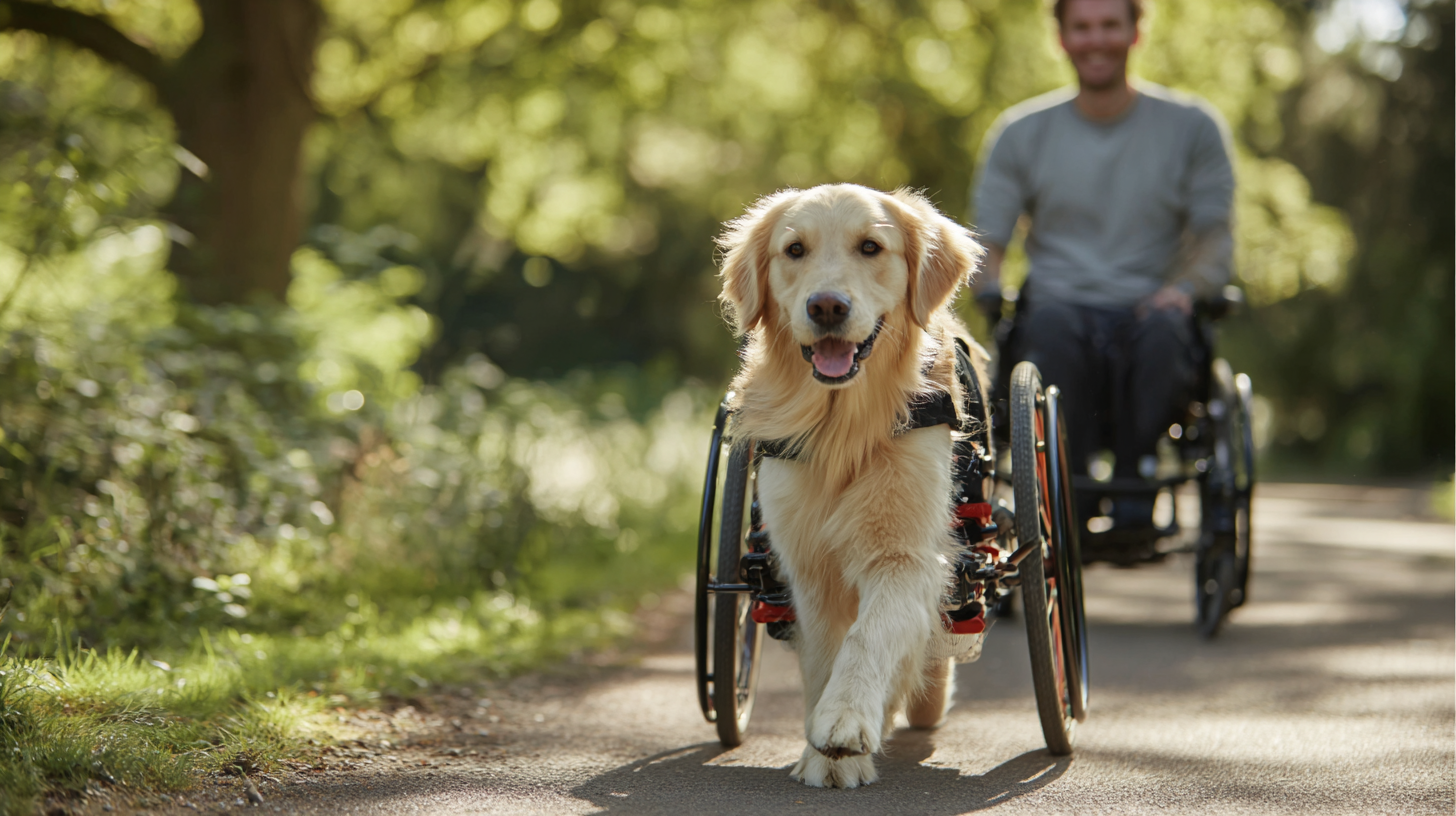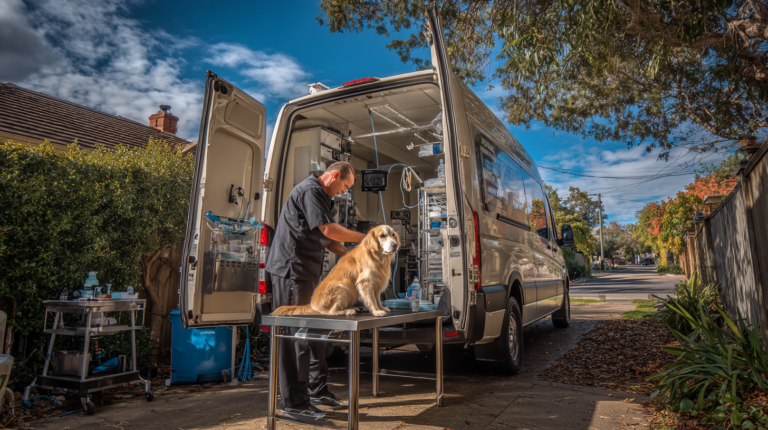Best dog wheelchairs 2025: Expert guide to mobility solutions for disabled dogs. Compare top-rated wheelchairs, fitting tips, and vet-approved advice for your pet’s needs.
Table of Contents
Did you know that over 14% of dogs will experience mobility issues during their lifetime, yet only 3% of owners know that dog wheelchairs can restore their pet’s quality of life? When your beloved companion struggles with mobility due to injury, illness, or age, watching them lose their independence can be heartbreaking. The good news is that modern dog wheelchairs have revolutionized how we support our four-legged friends, offering them a second chance at running, playing, and living life to the fullest.
A dog wheelchair isn’t just a mobility aid—it’s a gateway to renewed joy, exercise, and mental stimulation for dogs facing physical challenges. Whether your dog is recovering from surgery, managing a chronic condition like degenerative myelopathy, or adapting to life after amputation, the right wheelchair can make all the difference. This comprehensive guide will walk you through everything you need to know about choosing, fitting, and using dog wheelchairs effectively.
Understanding When Your Dog Needs a Wheelchair

Common Conditions That Benefit from Dog Wheelchairs
Dog wheelchairs serve as life-changing mobility solutions for various conditions affecting our canine companions. Understanding these conditions helps pet owners recognize when a wheelchair might be the right choice for their dog’s specific needs.
Degenerative Myelopathy affects the spinal cord and is particularly common in German Shepherds, Corgis, and Boxers. This progressive condition gradually weakens the hind legs, starting with subtle coordination issues and eventually leading to complete paralysis. Dogs with degenerative myelopathy often maintain their front-end strength, making them ideal candidates for rear-support wheelchairs.
Intervertebral Disc Disease (IVDD) frequently affects long-backed breeds like Dachshunds, Bulldogs, and Beagles. When spinal discs herniate or rupture, they can compress the spinal cord, causing pain, weakness, or paralysis. Many dogs with IVDD benefit from wheelchair support during recovery or as a long-term mobility solution.
Hip Dysplasia and Arthritis create chronic pain and mobility limitations, especially in larger breeds. While not always requiring full wheelchair support, dogs with severe hip dysplasia may benefit from rear-support wheelchairs to reduce pressure on painful joints and maintain activity levels.
Spinal Injuries from accidents, falls, or attacks can result in temporary or permanent paralysis. Wheelchairs provide immediate mobility support while healing occurs and serve as permanent solutions when recovery isn’t possible.
Amputations following injuries or cancer treatment don’t have to end your dog’s active lifestyle. Wheelchairs can help dogs adapt to life with missing limbs, providing stability and confidence during the adjustment period.
Warning Signs Your Dog Might Need Mobility Support
Recognizing the early signs that your dog could benefit from a wheelchair is crucial for maintaining their quality of life. Watch for these key indicators:
Difficulty Rising from lying or sitting positions, especially after rest, often signals developing mobility issues. Dogs may struggle to get up or require multiple attempts to stand.
Reluctance to Exercise or shortened walks when your previously active dog begins avoiding activities they once enjoyed. This behavioral change often indicates pain or physical limitation.
Dragging or Knuckling of the paws suggests nerve damage or weakness. You might notice worn nails on the affected paws or scrape marks on the ground.
Loss of Coordination in the hind legs, including wobbling, crossing legs while walking, or difficulty maintaining balance during movement.
Incontinence Issues may develop as spinal conditions progress, affecting your dog’s ability to control bladder and bowel functions.
Behavioral Changes such as increased anxiety, depression, or aggression can result from pain and frustration with mobility limitations.
Types of Dog Wheelchairs: Finding the Perfect Match
Rear-Support Dog Wheelchairs
Rear-support wheelchairs are the most common type, designed for dogs with hind leg weakness or paralysis while maintaining front-end strength. These wheelchairs support the dog’s rear end with a sling system while allowing the front legs to provide propulsion and steering.
Best For: Dogs with degenerative myelopathy, IVDD affecting the rear, hip dysplasia, or hind leg amputations.
Key Features: Adjustable rear sling, lightweight frame, and easy-access design for bathroom needs. The sling distributes weight evenly across the dog’s hindquarters, reducing pressure on sensitive areas.
Considerations: Dogs need sufficient front-end strength to propel themselves forward. The wheelchair should allow natural head movement and comfortable panting during exercise.
Front-Support Dog Wheelchairs
Front-support wheelchairs assist dogs with front leg issues while their hind legs provide propulsion. These are less common but equally important for dogs with front-end mobility challenges.
Best For: Dogs with front leg amputations, shoulder injuries, or conditions affecting the front limbs specifically.
Key Features: Chest support system, adjustable front wheel positioning, and secure harness design. The support system must accommodate the dog’s natural breathing and head movement.
Considerations: Dogs need strong hind legs to push themselves forward. The wheelchair must not restrict natural panting or interfere with the dog’s ability to regulate body temperature.
Full-Support Dog Wheelchairs
Full-support wheelchairs provide comprehensive mobility assistance for dogs with both front and rear mobility issues. These four-wheeled systems offer maximum support for dogs with extensive paralysis or weakness.
Best For: Dogs with complete paralysis, multiple limb amputations, or severe conditions affecting both front and rear mobility.
Key Features: Comprehensive support system, four-wheel design, and often motorized options. These wheelchairs require careful fitting to ensure comfort and proper weight distribution.
Considerations: Dogs may need assistance with steering and navigation. Full-support wheelchairs often require more training and adjustment time.
Temporary vs. Permanent Wheelchair Solutions
Temporary Wheelchairs serve dogs recovering from surgery or injury, providing support during the healing process. These often feature more adjustment options to accommodate changing needs during recovery.
Permanent Wheelchairs are designed for long-term use with dogs who have permanent mobility limitations. These prioritize durability, comfort, and easy maintenance for daily use.
Top Dog Wheelchair Brands and Models for 2025
Premium Dog Wheelchair Options
Walkin’ Wheels has established itself as the gold standard in dog wheelchair manufacturing. Their rear-support wheelchairs feature patented stirrup system that provides exceptional stability and comfort. The company offers extensive sizing options and excellent customer support, making them a top choice for first-time wheelchair users.
K9 Carts provides highly customizable wheelchairs with a focus on individual fitting. Their products feature adjustable components that can be modified as your dog’s needs change over time. The company’s attention to detail and quality construction makes their wheelchairs suitable for active dogs who need long-term mobility support.
Eddie’s Wheels offers both standard and custom wheelchair options with a reputation for durability and innovative design. Their wheelchairs feature lightweight materials and ergonomic design elements that prioritize dog comfort during extended use.
Mid-Range Quality Options
Handicapped Pets provides reliable wheelchair solutions at more accessible price points without compromising essential features. Their wheelchairs offer good adjustability and solid construction suitable for most dogs’ needs.
Best Friend Mobility focuses on user-friendly designs that make wheelchair use easier for both dogs and owners. Their products feature quick-release mechanisms and easy-to-clean materials that simplify daily care.
Budget-Friendly Alternatives
Amazon Basics Pet Wheelchairs offer basic mobility support at entry-level prices. While not as feature-rich as premium options, these wheelchairs can provide adequate support for dogs with temporary mobility needs.
DIY Wheelchair Kits allow handy pet owners to build custom wheelchairs using provided components and instructions. These options offer maximum customization at reduced costs but require time and basic construction skills.
Measuring Your Dog for the Perfect Wheelchair Fit
Essential Measurements for Wheelchair Fitting
Proper measurement is crucial for wheelchair effectiveness and your dog’s comfort. Incorrect sizing can lead to discomfort, skin irritation, and reduced mobility rather than improved movement.
Back Length Measurement: Measure from the base of your dog’s neck to the base of their tail along the spine. This measurement determines the frame length needed to properly support your dog’s body.
Chest Circumference: Wrap a measuring tape around your dog’s chest at the widest point, just behind the front legs. This measurement ensures the harness or sling provides adequate support without restricting breathing.
Ground to Chest Height: Measure from the ground to your dog’s chest at the point where the support sling will sit. This measurement determines the proper wheel height for natural movement.
Leg Length: Measure from the ground to the top of your dog’s shoulder and hip to ensure the wheelchair allows natural leg movement without interference.
Weight Consideration: Your dog’s weight affects wheel size, frame strength, and overall wheelchair design. Heavier dogs need more robust construction and larger wheels for stability.
Professional Fitting vs. DIY Measurement
Professional Fitting through veterinary clinics or specialized retailers ensures accurate measurements and proper wheelchair selection. Professionals can assess your dog’s specific needs and recommend appropriate features.
DIY Measurement is possible with careful attention to detail and manufacturer guidelines. Most wheelchair companies provide detailed measurement instructions and sizing charts to help owners measure correctly.
Common Measurement Mistakes include measuring while the dog is moving, not accounting for fur thickness, and failing to consider the dog’s posture changes throughout the day.
Step-by-Step Guide to Introducing Your Dog to a Wheelchair
Initial Introduction Phase
The first introduction to a wheelchair can be overwhelming for dogs, making a gradual, positive approach essential for success. Start by allowing your dog to investigate the wheelchair while it’s stationary, offering treats and praise for calm, curious behavior.
Day 1-2: Place the wheelchair in your dog’s living area without any pressure to interact. Allow them to sniff and explore the device at their own pace while providing positive reinforcement for any interest shown.
Day 3-4: Begin touching your dog with parts of the wheelchair, such as the sling or harness, while offering treats and praise. This helps them associate the wheelchair components with positive experiences.
Day 5-7: Practice putting the harness or sling on your dog for short periods without attaching the wheelchair frame. Start with just a few minutes and gradually increase the duration as your dog becomes more comfortable.
Fitting and Adjustment Process
Initial Fitting: The first time you place your dog in the wheelchair should be calm and patient. Have treats ready and keep the session short—just a few minutes initially.
Adjustment Period: Expect an adjustment period of 1-2 weeks as your dog learns to navigate with their new mobility aid. Some dogs adapt quickly, while others need more time and encouragement.
Gradual Increase: Start with 5-10 minute sessions and gradually increase the duration as your dog becomes more comfortable and confident with the wheelchair.
Training Tips for Wheelchair Success
Positive Reinforcement: Use high-value treats and enthusiastic praise to create positive associations with the wheelchair. Never force or rush the process, as this can create lasting negative associations.
Start Indoors: Begin training in a familiar, safe environment with minimal distractions. Once your dog is comfortable indoors, gradually transition to outdoor environments.
Practice Basic Commands: Teach or reinforce basic commands like “stop,” “slow,” and “wait” to help your dog navigate safely in their wheelchair.
Obstacle Navigation: Gradually introduce small obstacles and different surfaces to help your dog develop confidence and skills in various environments.
Maintenance and Care for Dog Wheelchairs
Daily Maintenance Routine
Cleaning After Use: Wipe down the frame and wheels with a damp cloth after each use to remove dirt, mud, and debris. Pay special attention to moving parts that can accumulate grime.
Sling and Harness Care: Remove and wash fabric components regularly to prevent odor and bacteria buildup. Most slings are machine washable, but check manufacturer guidelines for specific care instructions.
Wheel Inspection: Check wheels for wear, cracks, or embedded debris that could affect performance. Ensure wheels spin freely and aren’t binding against the frame.
Joint and Connection Points: Inspect all connection points for signs of wear or loosening. Tighten any loose bolts or connections to maintain structural integrity.
Weekly Deep Cleaning
Disassembly: Remove detachable components for thorough cleaning. This includes wheels, slings, and any removable padding or cushions.
Deep Cleaning: Use pet-safe disinfectants to clean all surfaces, paying special attention to areas that contact your dog’s skin. Rinse thoroughly and allow to dry completely before reassembly.
Lubrication: Apply appropriate lubricant to moving parts as recommended by the manufacturer. This prevents rust and ensures smooth operation.
Inspection: Conduct a thorough inspection of all components, looking for signs of wear, damage, or potential failure points.
Long-Term Care and Storage
Seasonal Considerations: Adjust cleaning frequency based on usage and environmental conditions. Dogs using wheelchairs in sandy or muddy conditions may need more frequent cleaning.
Storage: Store the wheelchair in a clean, dry location when not in use. Avoid extreme temperatures that could damage materials or components.
Replacement Parts: Keep common replacement parts on hand, such as wheels, bolts, and slings. This ensures minimal downtime if repairs are needed.
Common Mistakes to Avoid with Dog Wheelchairs
Sizing and Fitting Errors
Incorrect Measurements represent the most common mistake when selecting a dog wheelchair. Rushing the measurement process or measuring an uncooperative dog can lead to poor fit and reduced effectiveness.
Ignoring Weight Changes occurs when dogs gain or lose weight after initial fitting. Regular reassessment ensures the wheelchair continues to provide appropriate support as your dog’s condition changes.
Overlooking Comfort Features such as padding, breathable materials, and proper harness design can lead to skin irritation and reluctance to use the wheelchair.
Training and Introduction Mistakes
Rushing the Introduction by forcing a dog into a wheelchair before they’re ready can create lasting negative associations and training setbacks.
Inconsistent Training confuses dogs and slows the adaptation process. Consistent, positive training sessions yield better results than sporadic, lengthy sessions.
Inadequate Supervision during initial wheelchair use can lead to accidents, injuries, or negative experiences that hinder progress.
Maintenance and Care Oversights
Neglecting Regular Maintenance can lead to premature wear, safety issues, and reduced wheelchair lifespan. Consistent care maintains performance and safety.
Using Incorrect Cleaning Products can damage materials or create harmful residues that contact your dog’s skin. Always use pet-safe products as recommended by manufacturers.
Ignoring Wear Indicators such as worn wheels, loose connections, or damaged slings can compromise safety and effectiveness.
When to Consult Your Veterinarian
Medical Considerations
Pre-Wheelchair Evaluation: Always consult your veterinarian before purchasing a wheelchair to ensure it’s appropriate for your dog’s specific condition and overall health status.
Ongoing Monitoring: Regular veterinary check-ups help monitor your dog’s condition and adjust wheelchair use as needed. Some conditions may improve or worsen over time, requiring modifications to the mobility plan.
Pain Management: Discuss pain management strategies with your veterinarian, as some dogs may need medication to remain comfortable while using a wheelchair.
Skin Health: Monitor for pressure sores, chafing, or other skin issues that can develop from wheelchair use. Your veterinarian can recommend prevention strategies and treatments if problems arise.
Emergency Situations
Immediate Veterinary Care is needed if your dog shows signs of distress, pain, or injury while using a wheelchair. This includes difficulty breathing, excessive panting, or obvious discomfort.
Condition Changes such as sudden improvement or deterioration in mobility may require immediate veterinary evaluation and potential modifications to wheelchair use.
Behavioral Changes including increased anxiety, aggression, or depression may indicate pain or discomfort that needs professional assessment.
Success Stories and Real-World Examples
Case Study: Max’s Journey with Degenerative Myelopathy
Max, a 10-year-old German Shepherd, began showing signs of hind leg weakness at age 9. His owners initially attributed the subtle changes to normal aging, but as the condition progressed, Max struggled to maintain his balance and eventually began dragging his hind paws.
After veterinary diagnosis of degenerative myelopathy, Max’s family researched mobility options and decided on a Walkin’ Wheels rear-support wheelchair. The initial introduction took patience—Max was hesitant about the new device and required several weeks of gradual training.
The transformation was remarkable. Within a month, Max was confidently navigating his neighborhood in his wheelchair, chasing balls, and maintaining his role as the family’s active companion. His wheelchair allowed him to exercise regularly, which helped maintain his front-end strength and overall health.
Max’s story illustrates the importance of early intervention and proper training. His family’s commitment to gradual introduction and consistent use helped him adapt successfully to his new mobility aid.
Case Study: Bella’s Recovery from IVDD
Bella, a 6-year-old Dachshund, experienced sudden paralysis due to a severe disc rupture. After emergency surgery, her veterinarian recommended a wheelchair to support her rehabilitation and provide mobility during recovery.
Bella’s journey differed from Max’s because her condition had potential for improvement. Her wheelchair served as both a mobility aid and a therapeutic tool, allowing her to maintain muscle tone and mental stimulation during recovery.
After six months of combined physical therapy and wheelchair use, Bella regained significant function in her hind legs. While she still uses her wheelchair for longer walks and activities, she can walk short distances independently—a recovery that her veterinarian attributes partly to the early mobility support provided by the wheelchair.
Statistical Impact of Dog Wheelchairs
Recent studies indicate that dogs using wheelchairs show significant improvements in quality of life markers. According to research published in the Journal of Veterinary Rehabilitation, 87% of dogs using wheelchairs maintained or improved their activity levels compared to pre-mobility issues.
The same study found that dogs with wheelchair access showed reduced signs of depression and anxiety, with owners reporting more positive behaviors and maintained social engagement. These findings support the psychological benefits of mobility maintenance for dogs with physical limitations.
Debunking Common Dog Wheelchair Myths
Myth 1: Wheelchairs Are Only for Paralyzed Dogs
Reality: Wheelchairs benefit dogs with various mobility issues, from temporary post-surgical support to assistance with arthritis and hip dysplasia. Many dogs use wheelchairs part-time to maintain activity levels while managing pain or weakness.
Expert Perspective: Dr. Sarah Martinez, a veterinary neurologist, explains that wheelchairs can actually help prevent further deterioration in some conditions by maintaining muscle tone and joint mobility through continued exercise.
Myth 2: Dogs Can’t Live Normal Lives in Wheelchairs
Reality: Dogs using wheelchairs can participate in most normal activities, including playing, swimming (with waterproof models), and social interaction. Many wheelchair-using dogs maintain their personalities and energy levels.
Evidence: Countless videos and stories from wheelchair-using dogs demonstrate their ability to run, play fetch, interact with other dogs, and even participate in adaptive sports competitions.
Myth 3: Wheelchairs Are Uncomfortable and Restrictive
Reality: Modern wheelchairs are designed with comfort and freedom of movement in mind. Proper fitting and gradual introduction ensure dogs can move naturally while receiving necessary support.
Professional Insight: Physical therapists working with disabled dogs report that well-fitted wheelchairs often increase comfort by reducing pain and strain on compromised limbs.
Advanced Wheelchair Features and Innovations
Technological Advances in Dog Wheelchairs
Lightweight Materials: Modern wheelchairs use advanced materials like carbon fiber and aircraft-grade aluminum to reduce weight while maintaining strength. Lighter wheelchairs require less energy for dogs to propel themselves.
Adjustable Components: New designs feature tool-free adjustment systems that allow owners to modify fit and support levels easily. This flexibility accommodates changing needs and ensures optimal comfort.
All-Terrain Wheels: Specialized wheel designs enable dogs to navigate various surfaces, from sand and snow to rocky terrain. Different wheel sizes and tread patterns optimize performance for specific activities.
Quick-Release Systems: Modern wheelchairs feature quick-release mechanisms that allow rapid attachment and removal, making it easier to transition between wheelchair use and rest periods.
Specialized Wheelchair Accessories
Protective Gear: Booties, knee pads, and chest protectors help prevent injury during wheelchair use. These accessories are particularly important for dogs learning to navigate their new mobility aid.
Storage Solutions: Attachment systems for waste bags, water bottles, and small items allow dogs and owners to carry essentials during outings.
Weather Protection: Waterproof covers and all-weather materials ensure wheelchairs remain functional in various environmental conditions.
Comfort Enhancements: Padded slings, breathable fabrics, and ergonomic designs improve comfort during extended use periods.
Financial Considerations and Insurance Coverage
Cost Analysis of Dog Wheelchairs
Initial Investment: Quality dog wheelchairs range from $200 for basic models to $800 for premium, custom-fitted options. The initial cost depends on size, features, and customization requirements.
Long-term Value: When compared to ongoing medication costs, physical therapy sessions, and potential quality of life improvements, wheelchairs often provide excellent value over time.
Maintenance Costs: Regular maintenance, replacement parts, and accessories add to the total cost of ownership. Budget approximately $50-100 annually for maintenance and replacement components.
Insurance and Financial Assistance
Pet Insurance Coverage: Some pet insurance policies cover mobility aids as part of rehabilitation treatment. Check with your insurance provider about coverage options and requirements.
Veterinary Payment Plans: Many veterinary clinics offer payment plans that can include wheelchair purchases as part of treatment plans.
Charitable Organizations: Several organizations provide financial assistance for mobility aids for pets whose owners demonstrate financial need. Research local and national programs that support disabled pets.
Fundraising Options: Online crowdfunding platforms have helped many families raise funds for their pets’ mobility needs through community support.
Future Trends in Dog Mobility Solutions
Emerging Technologies
Smart Wheelchairs: Integration of sensors and monitoring systems that track usage patterns, activity levels, and health metrics represents the future of pet mobility aids.
3D Printing: Custom wheelchair components created through 3D printing technology offer perfect fits and rapid replacement part availability.
Robotic Assistance: Advanced robotic systems that provide powered assistance for dogs with limited strength are under development, potentially revolutionizing mobility support.
Rehabilitation Integration
Therapeutic Wheelchairs: Devices designed specifically for rehabilitation purposes, featuring adjustable resistance and support levels to aid in recovery.
Biometric Monitoring: Integration with wearable technology to monitor vital signs, activity levels, and recovery progress during wheelchair use.
Virtual Reality Training: VR systems that help dogs adapt to wheelchair use through controlled, positive experiences in virtual environments.
Educational Table
Markdown Version:
For more expert pet care tips and product recommendations, visit BlithePet.com your trusted source for pet wellness.
FAQ Section :
Q: How do I know if my dog needs a wheelchair?
A: Signs include difficulty rising, reluctance to exercise, dragging paws, loss of coordination in limbs, and behavioral changes indicating pain or frustration. Consult your veterinarian for proper evaluation if you notice these symptoms.
Q: Can dogs with wheelchairs still go to the bathroom normally?
A: Yes, most dog wheelchairs are designed with easy bathroom access. Rear-support wheelchairs typically have open access for natural elimination, and many dogs adapt quickly to the process.
Q: How long does it take for a dog to adjust to a wheelchair?
A: Most dogs adapt within 1-2 weeks with proper introduction and training. Some dogs take to wheelchairs immediately, while others may need several weeks of gradual exposure and positive reinforcement.
Q: Are dog wheelchairs covered by pet insurance?
A: Coverage varies by insurance provider and policy. Some insurers cover wheelchairs as part of rehabilitation treatment, while others may exclude them. Check with your specific insurance provider for coverage details.
Q: Can dogs swim while wearing a wheelchair?
A: Special waterproof wheelchairs are available for swimming, but standard wheelchairs should not be used in water. Always supervise swimming activities and ensure the wheelchair is designed for aquatic use.
Q: How much exercise can a dog in a wheelchair get?
A: Dogs in wheelchairs can often maintain or even increase their exercise levels compared to their mobility-limited state. Start with short sessions and gradually increase duration based on your dog’s comfort and energy levels.
Q: What’s the difference between custom and standard wheelchairs?
A: Custom wheelchairs are individually designed and built for your dog’s specific measurements and needs, offering perfect fit and specialized features. Standard wheelchairs come in predetermined sizes with adjustable components and are more affordable with faster delivery times.
Conclusion
Dog wheelchairs represent more than just mobility aids—they’re tools that restore independence, dignity, and joy to our beloved companions facing physical challenges. From the initial recognition of mobility issues to the successful integration of a wheelchair into your dog’s daily life, the journey requires patience, understanding, and commitment.
The key to success lies in proper selection, fitting, and introduction of the wheelchair, combined with ongoing maintenance and veterinary support. Remember that every dog’s journey is unique, and what works for one may not work for another. The most important factor is your dog’s comfort, safety, and quality of life.
Modern wheelchairs offer unprecedented opportunities for dogs with mobility limitations to maintain active, fulfilling lives. With proper care and support, dogs using wheelchairs can continue to experience the joy of movement, exploration, and companionship that makes life meaningful.
Whether you’re just beginning to consider a wheelchair for your dog or you’re seeking to optimize an existing mobility solution, remember that you’re not alone in this journey. The community of dog wheelchair users, manufacturers, and veterinary professionals provides extensive support and resources to help you and your dog succeed.
Have a similar experience with your pet? Share it in the comments below! Don’t forget to check out our other helpful guides at BlithePet.com for more expert advice on caring for your furry family members.







